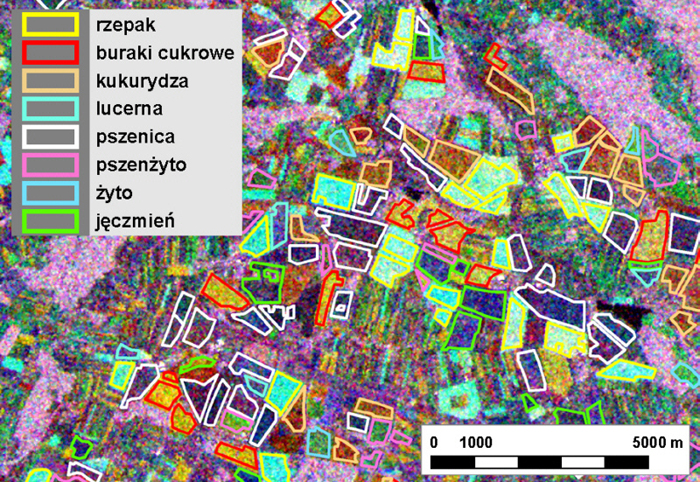The analysis of conditions for recognition of crops on microwave satellite images
The analysis of conditions for recognition of crops on microwave satellite images
Grant IGIK G-83
Project leader: Dr Krystyna Stankiewicz
25-08-2004 - 24-02-2007
 The aim of the project was to analyze the conditions under which the crop recognition on microwave satellite images is the most accurate. Microwave satellite images are the valuable source of data for Earth monitoring because they can be acquired almost in all-weather conditions. Due to this fact such images can be effectively used for vegetation monitoring during the whole life cycle of plants. However, microwave backscattering depends on a canopy architecture as well as on some other randomly changing factors. The most important factors influencing the microwave image of land surface are the following: biomass distribution, vegetation water content, soil fractional coverage and surface soil moisture. Water content in plants as well as in the uppermost soil layer that control the scattering of microwave beam from land surface vary significantly in space and time. Crop recognition on microwave images is the most accurate over areas with high moisture stability during the period of investigation.
The aim of the project was to analyze the conditions under which the crop recognition on microwave satellite images is the most accurate. Microwave satellite images are the valuable source of data for Earth monitoring because they can be acquired almost in all-weather conditions. Due to this fact such images can be effectively used for vegetation monitoring during the whole life cycle of plants. However, microwave backscattering depends on a canopy architecture as well as on some other randomly changing factors. The most important factors influencing the microwave image of land surface are the following: biomass distribution, vegetation water content, soil fractional coverage and surface soil moisture. Water content in plants as well as in the uppermost soil layer that control the scattering of microwave beam from land surface vary significantly in space and time. Crop recognition on microwave images is the most accurate over areas with high moisture stability during the period of investigation.
It was also confirmed during some earlier investigations performed by IGIK in Wielkopolska. Our target was to answer the question whether it is possible to identify crops on microwave images with sufficient accuracy despite the variations of soil moisture and vegetation status. The influence of image registration parameters on crop discrimination accuracy was also considered. The project was based on ENVISAT ASAR images acquired during the growth periods starting from the year 2003 till 2006. Test site area is located in the western part of Poland in Wielkopolska. Field campaigns were correlated in time with the satellite overpasses. Type of crops was observed on several hundreds of fields and the measurements of wet biomass and soil moisture were taken selectively.
These data were considered during the analysis of crop recognition on various sets of ASAR images. Numerous recommendations aiming on the most effective crop recognition on ASAR images were specified as a result of the analysis. These recommendations concern the following:
- selection of image registration parameters
- time schedule of image registration
- selection of ancillary data on the investigated area
- image preprocessing methods
- algorithms of automatic classification
